
39 minute read
Mazaruni Prisons P
Prison escapes Joint Services’ Heads inspect Mazaruni Prisons
Following a recent prison break from the high-security Mazaruni Prison in Region Seven (Cuyuni-Mazaruni), Heads of the Joint services on Friday conducted a physical inspection of the facility.
On February 16, four prisoners, including inmates on death row who were convicted for murder and manslaughter, escaped from the high-security Mazaruni Prison in Region Seven (Cuyuni-Mazaruni).
Those who had escaped were 25-year-old Imran Ramsaywack of Adelphi Village, East Coast Berbice (ECB); 44-year-old Kenrick Lyte whose last known address was Grant Good Intent, Lower Pomeroon River; 22-year-old Samuel Gouveia of Goedverwagting, East Coast Demerara (ECD), and 22-year-old Rayon Jones of Timehri, East Bank Demerara (EBD).
Then on April 9, Kevin Lafleur of Providence Housing Scheme, EBD, who was serving a 56-month sentence after he was convicted for robbery under arms, also escaped from the Mazaruni Prison.
As such, on Friday, the Guyana Prison Service hosted a Tactical Exercise Without Troops (TEWTs) at the facility.
In attendance were Head of the Guyana Defence Force, Brigadier Godfrey Bess DSS; Commissioner of Police (ag), Nigel Hoppie DSM; Director of Prison (ag), Nicklon Elliot; Guyana Fire Service representative Commandant Heimchendra Persaud and presidential Advisor on National Security, Gerry Gouveia.
The TEWT activity had presentations from members of the Joint Services where they each presented on their area of responsibility in relation to a prison break, shooting incident and fire - all occurring around the same time.
On February 16, the Guyana Prison Service (GPS) said that at about 07:15h during the unlocking of the Brick Prison – Solitary Division – it was observed that the padlock to the entrance gate was tampered with, and further checks revealed that two bars within the cell were cut. It was then they discovered that Ramsaywack; Lyte; Gouveia and Jones were missing.
On March 22, Ramsawack and Jones were killed during a shootout with Police at about 20:40h at the Better Hope Backlands, East Coast Demerara (ECD). Lyte and Gouveia are still on the run.
Meanwhile, Lafleur on April 9 at about 03:15h made a run for his freedom into the bushes aback the prison. According to Police, Prison Officers scoured the area but did not locate the escapee. He was reportedly spotted in Bartica but continues to evade Police.

Heads of the Joint Services, Brigadier Godfrey Bess DSS; COP Nigel Hoppie DSM; Director of Prisons (ag) Nicklon Elliot, and GFS representative Commandant Heimchendra Persaud inspecting the prison



SUNDAY, APRIL 18, 2021 | GUYANATIMESGY.COM

British-induced famines and Indian Indentureship
With Indian Arrival Day less than three weeks away, we are reminded that between 1838 and 1917, 239,000 Indians were brought as “indentured labourers” for the sugar plantations of Guyana, and a similar number were brought to the West Indies.
The question arises as to why these persons left their country when their custom forbade “crossing the “Black Waters” (Kala Pani)”. The short answer is that, structurally, it was ultimately and literally a matter of life and death.
While indentured labour might be seen as a transitory passage of human labour from chattel slavery to the so-called “free labour” of Ravi Dev today, the conditions that herded Indians into that option were man-made. The sugar planters had no faith that the free Africans would sell their labour at a rate to make sugar profitable. They therefore actively sought a new supply of labourers that would guarantee such cheap labour on demand. But where would such rates - that could not attract freed slaves - be a “pull factor” for indentureship? The answer was British India.
The story begins in 1757, when the troops of the British East India Company captured Bengal from the Moguls, and completed their inexorable conquest of the legendarily rich India within 50 years. Less than a decade later, between 1768 and 1771, from Bengal and Eastern Bihar (from where most Guyanese immigrants originated), more than 10 million persons - one third of the population – died from a “famine”. Why? Two reasons. Firstly, the farmers who supplied the bulk of the population with foodstuffs were forced by the British into producing cash crops for export – even while they were forced to pay onerous taxes at the threat of death and violence.


We quote the words of then British Governor Warren Hastings, who boasted to the home office: “Notwithstanding the loss of at least one-third of the inhabitants of the province, and the consequent decrease of the cultivation, the nett collections of the year 1771 exceeded even those of I768… It was naturally to be expected that the diminution of the revenue should have kept an equal pace with the other consequences of so great a calamity. That it did not was owing to its being violently kept up to its former standard.”
The cash crops the farmers were forced to grow included cotton, poppy (for opium) and indigo, and as described above, this was simply to keep paying off the extortionate demands of the British, who exported rice and wheat even during the famines. Millions were also thrown out of work when the British forbade Indian weavers from producing cotton yarn and the cotton fabrics that had enthralled Europe. Henceforth, only cotton woven by British looms could be sold in India! Where were the weavers to get the money to buy food, much less clothes?
Incidentally, Britain became the largest drug dealers up to the present, with the opium – up to 800 tons annually – being shipped to China so that the British could buy Chinese tea.
Between the Bengal famine of 1768 and the end of Indentureship in 1917, conservatively, over 54 million Indians perished from famine. In the book Late Victorian Holocausts (2001), Mike Davis describes how Viceroy Lord Lytton insisted that wheat be exported to England. In 1877 and 1878, at the height of the famine, when 10.3 million persons perished, grain merchants exported a record 800,000 tons of wheat and 1.9 million tons of rice. As the peasants began to starve, officials were ordered “to discourage relief works in every possible way”.
And this is why the upsurge of indentured Indians correlated with the British-induced famines.
Police patrol stumbles upon car left on fire
Police on patrol on Friday evening stumbled upon a car left on fire at Green Field Access Road (Stadium Road), Providence, East Bank Demerara.
According to Police, the discovery was made at about 21:15h by ranks from Regional Division 4B who observed a white Toyota Spacio vehicle on fire. Ranks immediately summoned the Guyana Fire Service and a water tender from the Diamond Fire Station went to the scene to extinguish the vehicle. However, by that time the car was completely burnt.
Police also confirmed that the scene was processed and no casualty reported. Law enforcement officers have since made checks of CCTV cameras leading to and from the location to aid in the ongoing investigation.
Almost a month ago, Police found a white wagon, which is suspected to have been used in the execution of Ricardo Fagundes, on fire at Swan, LindenSoesdyke Highway.
The vehicle was found 24 hours after Fagundes, called “Paper Shorts”, of Sandy Babb Street, Georgetown, was executed outside a popular nightspot on Main Street, Georgetown. The 42-year-old gold dealer was shot dead after he exited the night club, having received a phone call. Reports are the man was partying with a group of friends at the bar when his phone rang and he exited the club to take the call, but soon after, several gunshots were heard. Based on reports, the now dead man’s friends rushed out to enquire but found Fagundes lying motionlessly in a pool of blood close to his motor car. Emergency Medical Technicians (EMTs) arrived shortly after the shooting and pronounced Fagundes dead.
Even as investigations continue into the man’s murder, Police have still not confirmed if it is the same car used in the execution. (G9)
The vehicle on fire at Greenfield Access Road, Providence, East Bank Demerara








SUNDAY, APRIL 18, 2021 | GUYANATIMESGY.COM

By Raywattie DeonaRine

Atrip to the Essequibo Coast is not complete without a drive to Lima, for what could be considered the country’s best duck curry, at Jagdesh’s Duck Curry Bar.
The duck curry there is so good that Guyanese from across the country would venture there just to have the meal. Whether it is with roti or dhal and rice, the star is and will always be the award-winning duck curry.
Jagdesh Duck Curry Bar is owned and operated by Jagdesh Bissessar and his wife Mohanie
along with his four children.
For over two decades, Bissessar has been perfecting his method of currying duck and the awards he would have won at various competitions just show that he is indeed the best there is in Guyana.
Jagdesh’s duck curry has become a household name and it is beyond a shadow of a doubt that it is one of the tastiest duck curries that is on the Essequibo Coast and further afield. Even foreigners, when they visit Guyana, would
request a trip to the Cinderella County to Jagdesh’s place to sample his delicious duck curry with dhal and rice.
Bissessar’s duck curry is made with just the right combination of spices and he said that the secret ingredient is his “magic fingers.”
The Sunday Times recently sat down with Bissessar where he shared his journey. He said that the business was started in 1995 when he operated a small grocery shop and bar. He reminisced that he was motivated by all the duck curry competitions he kept winning and as such decided to put his talent into a business by establishing his own restaurant.
From a simple grocery shop, Bissessar extended by adding an upper flat and more onto his bar. The curry master also mentioned that the business is a family one and his wife and kids manage it in his absence.
He is currently passing on the trade to his son who is slowly taking the reins.
“Everyone can cook and serve and I proudly handed the trade to my son who is very dedicated to serving persons,” he said.
When he first started out, Bissessar would cook 2 ducks daily but now it has grown so much that he prepares at least 22 ducks on a daily basis. That just goes to show how much his business has grown and the demand for his duck curry increased.

Magical Chef Jagdesh Bissessar receiving his award after he won a duck curry competition A serving of Jagdesh’s delicious duck curry Jagdesh Duck Curry Bar counter table


TURN TO PAGE 17





By UtamU Belle
The belief that she could create a successful business and earn the respect of friends and business acquaintances is just one of the driving factors which motivated Lindener Kenisha Fernandes to become an entrepreneur.
The thirty-year-old woman is the visionary mind behind the food entity, Bon Appétit 592 which prides itself by living up to its slogan, “We create food for the soul”.
Based in Wisroc, Linden, the entity which was birthed in June of last year offers delectable food on its daily menu and caters for public and private events. Apart from soul food, the entity also provides its unique line of fruit juices titled “592 Juices”.
“Offering a valuable service to customers made me pride myself on doing the best job possible,” the budding entrepreneur told Sunday Times during an interview.
Fernandes then went on to talk about how it all started for her.
“I do believe I've always had a passion for cooking and it started at the age of twelve. As I got older, I began doing research which led to me creating my own recipes,” she said.
As she grew older, so did her passion and she was determined to make it into something productive. The name Bon Appétit is quite a catchy and unique one, and according to Fernandes, her main aim behind its creation was to create a lasting impression.
“The main idea behind my business name is basically uniqueness. I created the name so that persons could embody my brand and know that it's something that's going to be memorable,” she stated.
Creating wholesome recipes has its fair share of challenges, the entrepreneur agreed, but she always finds ways in making it work.
“Some of the challenges I face are sometimes sourcing ingredients for recipes and catering to customers out of my region, but then I improvise and get the job done,” she shared.
Fernandes said despite challenges, her experience thus far has been fulfilling, which provides a great sense of accomplishment.
“I enjoy the feedback from customers the most. Great food and happy customers equal a thriving business,” she quipped as she explained that the support from members of the community also went beyond her expectations. According to Fernandes, the level of support has been “tremendous” thus far.
In just a few months, her food entity will celebrate a year of being in existence across Guyana and that's truly a goal I'm pushing for,” she stated.
Tapping in with a bit of advice for young entrepreneurs who are thinking


about walking down a familiar path, Fernandes advised them to “invest in your brand and always believe that you can make it big”.








Dada’s Grill at Tuschen, East Bank Essequibo
By Lakhram Bhagirat
With a brotherhood that is just over two years old, Ken Rampersaud and Michael Kassim are considered the proverbial “two peas in a pod” when it comes to their ideals and business acumen.
Collectively, the duo operates the Dada’s brand located at Tuschen, East Bank Essequibo, and according to Ken, they are “young enthusiastic men working to shape the Dada’s brand while being bounded in kinship for the partnership to go ahead.”
Under the Dada’s brand, there are a number of ventures namely Dada’s Grill, Castle Royal Hotel, Ten 11 Lounge all located in the Tuschen area. As part of the Dada’s foundation, they are also heavily invested in the operation of a kids home on the West Coast of Demerara and would constantly give back to communities within Region Three (Essequibo Islands-West Demerara).
Ken, a 37-year-old microbiologist by profession, said that Dada’s was a concept put together after some relatives visited from overseas and he realised that they needed to travel out of the region to have a good dining experience. That caused him to begin thinking about establishing a space that offers fine dining in a relaxed atmosphere and that is how Dada’s Grill came about. “I wanted a place that offered some upper to middle-class experience for us so we decided to give thought to establishing something like that. The owners of the property are key investors in it (Dada’s Grill). Myself and Michael are managing personnel here in terms of getting the whole idea on the ground,” he said.
When the two came together they both had a similar vision of how they wanted the Dada’s experience to be.
“We wanted to establish somewhere that persons on the west side (West Demerara) can have that type of ambience where they can experience a chilled environment, an area where they would be able to experience good dining concepts and be able to touch on a variety of foods that can be able to tantalise them rather than the regular (fast options) that we would often have on this end,” Ken recounted.
Dada’s Grill was opened at Public Road Tuschen in October of 2019 and was immediately a hit with the patrons at that end. However, in order for the young team to get the restaurant to where they wanted it to be, they had to overcome a number of challenges.
“The concept of outdoor recreational facility is something that isn’t quite popular on this one end so it’s a Miami California kind of concept that we would have merged and we had to work to convince them (customers) that this is what they needed,” Ken explained.
Michael is the person that is more on the ground pushing the Dada’s Grill brand whether it is procuring supplies or training staff. He said that as a unit, the management believes in sticking to their Standard Operating Procedures (SOPs) so as to ensure that every customer gets the best experience.
While the food may be the star, they believe that the ambience is what keeps their customers returning for more.
“We do regular trainings with our staff to ensure that we offer the service that persons are going to be impressed with. We are differentiating ourselves from the others and we have been pushing for it at all our facilities,” Michael said.
The 30-year-old mixologist said that initially, they would have had issues in getting the right staff to complement their vision but noted that they are now at a place where they have the right staff to execute the vision.
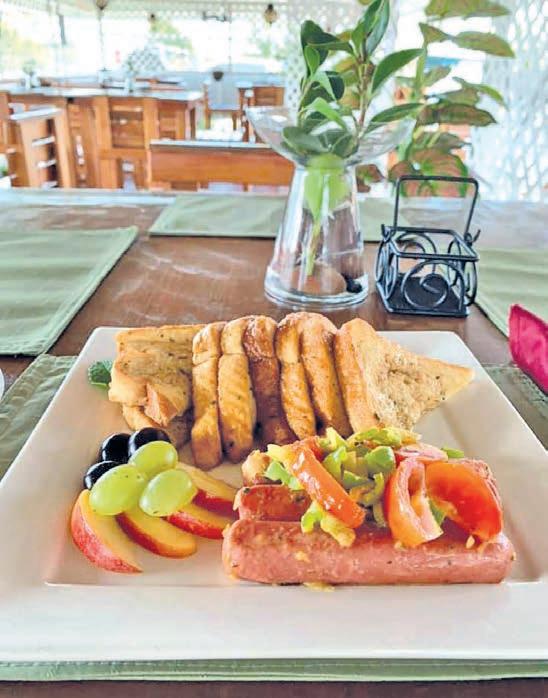

TURN TO PAGE 18





FROM PAGE 13


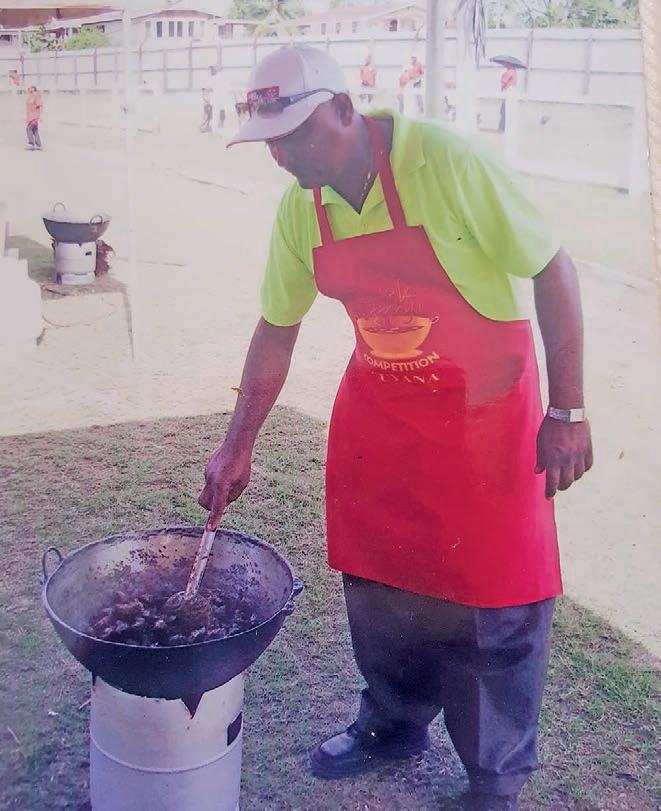
Jagdesh and his team were delighted after they won the duck curry competition
Persons visiting the Essequibo mostly stop off at the popular Jagdesh Duck Curry Bar for not only duck curry but other meals as well. Bissessar was asked if he has any special ingredients for his duck and mutton curries, he smiled and said that is a secret he will not tell but it’s all about the magic fingers God blessed him with. Bissessar and his wife Mohanie have been participating in duck curry competitions for a long time. In 2008 they formed a crew and represented Essequibo at a national competition and gained the second position. Moreover, in 2009, they placed third and qualified to take part in another competition and cooked their way to first place in Berbice.
This made the crew more motivated. They defeated the Surinamese in a neighbourly competition. They would have also participated in competitions in Trinidad and even won there in 2010.
“I took part in all these competitions because of the passion I have for cooking and it’s the magic fingers that cook the pots. I’ve learned cooking at the age of 7 and as such, it became my speciality,” he said.
Over the past years, the magical chef won 12 trophies, 4 of which are for mutton curry and 9 for duck curry competitions. Jagdesh is now accommodating more persons and a lot of persons, especially from Georgetown, are often craving his curry.
The COVID-19 pandemic did not affect business for him since he became innovative and began adapting.
Jagdesh Bissessar cooking his favourite duck curry


FROM PAGE 15
Foodies
It makes no sense being in the food business and not have an appreciation for food in all forms. Luckily, for Ken and Michael, they are both “foodies”. While Ken lives more on the healthier side of the food lane, Michael just “digs in” on what is placed in front of him.
For them, the main challenge would have been crafting a menu that offered a little bit of everything for everyone.
It is no secret that Guyanese are quite reluctant when it comes to exploring the culinary world and that is understandable because Guyanese cuisine is so vast and an incorporation of so many cultures.
Nevertheless, Ken and Michael embarked on an intense food education drive and hosted several sampling meets before they decided on what their menu would include. Now, they can successfully say that they have converted most persons to shy away from the regular fried rice, chowmein and chicken and introduced them to lamb chops, steaks, various kinds of pasta and wine.
They are actively working on introducing new items on their menu on a monthly basis so as to shy away from becoming a robotic establishment with limited options.
“Our big sellers have been chicken over rice, our BBQ pork have been something that been rushed after. We offer 8 variety of wings so we are known as the wing spot at this end. Our doubles is something that goes fast here and another is the roti and balanjay choka goes excellently. Trust me when you have that roti and balanjay choka you will never want it from anywhere else,” Michael boasted.
The duo is also planning on extending the Dada’s brand to the various regions in Guyana and also the Caribbean. They have been in talks with persons in Trinidad, Barbados and Suriname to establish there.
COVID-19 and philanthropy
Months after opening and building a following Dada’s was forced to halt all operations after Guyana discovered its first set of COVID-19 cases. The then Government imposed restrictions and that saw the restaurant industry being brought to a standstill.
“For the first three months (after COVID-19 restrictions) it would have impacted us greatly in the sense that we had to lay off all the staff and close business,” Michael said.
With both men coming from humble beginnings – Ken, a farmer’s son from Bonasika Creek and Michael from Berbice – they both have been heavily involved in philanthropic activities. They realised that Dada’s offered them an avenue to become even more involved in helping out the community.
After they laid off all their staff, they still supported them by offering loans to meet expenses and distributing hampers. On a monthly basis, the Dada’s team would distribute over 50 hampers to persons in need within their community.
“Our passion is more in philanthropy and giving back to the community. We work with the Guyana Police Force, the NDCs to give back to our communities and that has been something that has assisted us significantly with the business in terms of partnering with these personnel and letting the community know that we care. By persons knowing that we are not all about making money, they would choose to support us because they know when they do that then the community will benefit.
“We are passionate about philanthropy and at the end of the day, I don’t think nothing makes a human feel better than impacting another human being where they have nothing to gain in response other than that joy. In that type of aspect, we want to try to touch lives. Dada’s grill is something that is impactful. This isn’t only about money but the impact on our communities. We came from humble beginnings and we think we can really make an impact on the lives of young people,” Ken said.
Since the restrictions were lifted, they have reopened while adhering to the guidelines outlined by the National COVID-19 Task Force. They have also turned to other parts of the world for best practices in operating during COVID-19.
For now, Ken and Michael intend to continue serving up exceptional food with a side of philanthropy not just to Region Three residents but to all of Guyana.

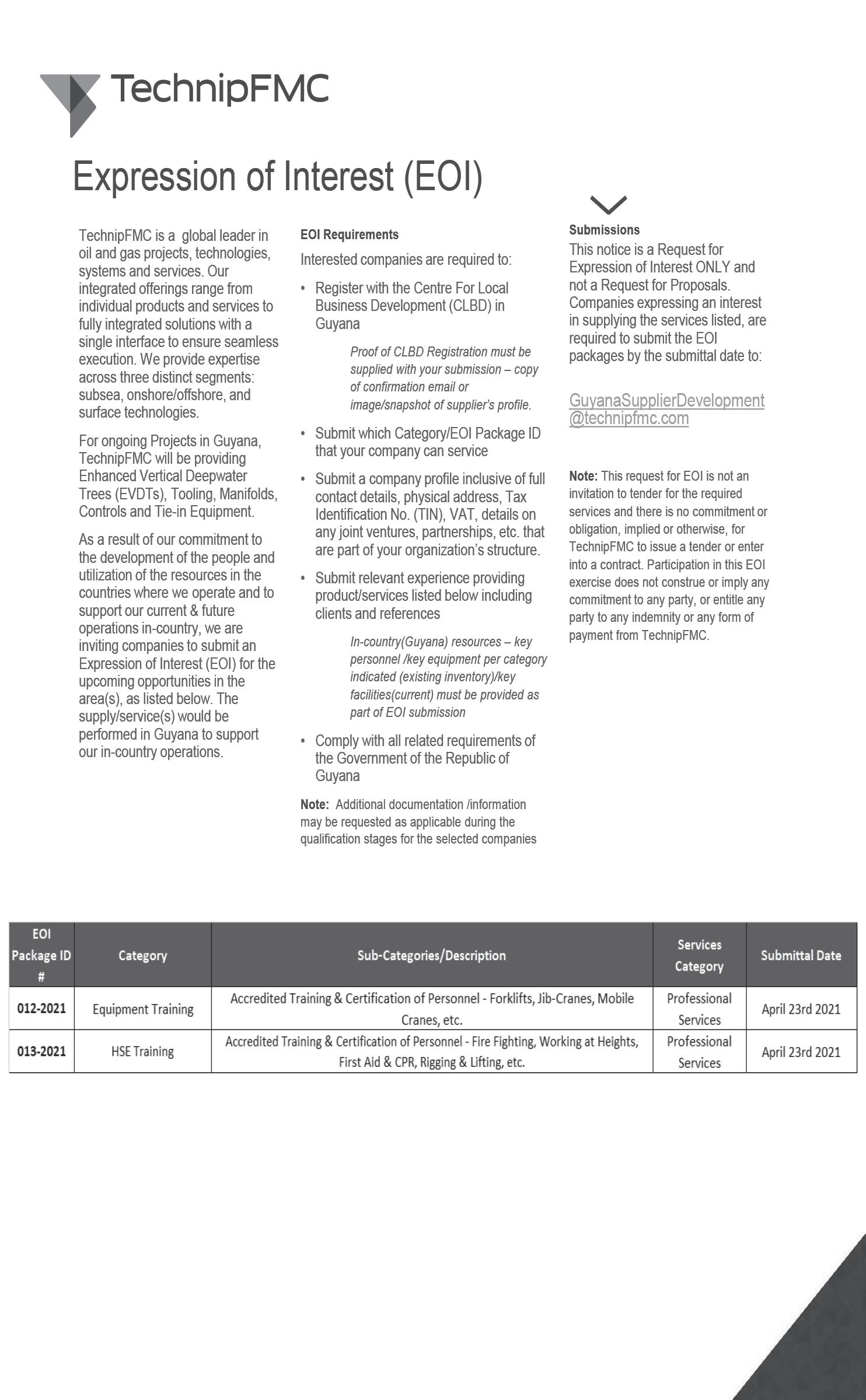






By Lakhram Bhagirat
Pyramid Restaurant and Pub is perhaps one of the more unique restaurants in Guyana because of its location overlooking the majestic Atlantic Ocean at La Jalousie, West Coast Demerara.
For owner, Safraz Khan, the idea is one that was birthed just over 10 years ago when he was in the fastfood business. The 38-yearold entrepreneur said that the idea is one that seeks to offer a relaxed atmosphere for wholesome family time and with its current location, Pyramid achieves just that.
“I have been an entrepreneur pretty much all my life. I have been involved in several businesses. I established the first international fast food in West Demerara and that is Chester’s Chicken and prior to that I have been in electronics and so and now I am back in the food business with a little twist. Pyramid is what you call a fast-casual restaurant which is a restaurant with a touch of drinks and some food,” Khan explained.
The business has been in operation for just a few months and according to Khan, they are steadily improving on the quality of food and facilities as well. He noted that they are capitalising on the uniqueness of the restaurant by establishing both fast food options as well as a hint of fine dining.
Noting that they have not yet realised full operation owing to the ongoing coronavirus (COVID-19) pandemic, they are still grateful to be able to operate.
“Pyramid is an old idea I had a little while going back while I was in the fried chicken business. I thought if I ever go back or expand in this area, I will do a fast-casual restaurant because the fast-food with chicken and fries and pizza has gotten very saturated because the big players are in so I wanted to get out,” he said.
The father of one said that Pyramid, when fully operational, will be Egyptian themed, explaining that the servers would be attired in their ancient Egyptian garb
as well as the space transformed with various artefacts.
Currently, the restaurant has a big deck overlooking the Atlantic. When one is seated there, the atmosphere is tantamount to the “seawall lime” where there is food and soft music. At Pyramid, the food often competes with the view for the top spot and most of the time, the food wins.
While it may be a small menu at this time, Khan related that they are focused on perfecting what they have as well as introducing patrons on the Western end of Demerara to a different experience. He said that they have achieved that with the introduction of the full wine bar.
The food there is heavily Asian-inspired but Khan also capitalises on his fastfood background and includes some of the classics.
“For us, one of the hardest things is that you don’t get trained chef so you have to design a menu based on what people go for a lot and what you can get regular people and train them to do. We have burgers and pizzas, wings and so on. We have main courses – focused on more Asian style – pasta and so on. There is a lot more to come because we are at the point, we don’t want to over-plan the menu,” he explained.
Pyramid currently creates employment for over a dozen persons and that number is slated to increase as expansion works are completed.
Khan, when asked what advice he would have for someone entering the world of entrepreneurship, said “You have to be very dedicated and focused. You have to be willing to make sacrifices. You have to be so focused on what you doing that sometimes you have to sacrifice friendships because too much distractions will take away from what you are doing. Businesses are more difficult to start in Guyana now so now you have to know the market, do research and remain focus. I always tell young people too to invest in building networks and approach things with an open mind.”




HEALTH TIPS

SCABIES

Dr Tariq Jagnarine Fam meDicine, enDocrinology/DiabeTes
Scabies is one of several skin conditions that can cause itching and rashes. It is a dermatologic condition caused by sarcoptes scabiei, an eight-legged microscopic mite. • While the scabies mite needs skin to feed on and survive, it can live without a human host for 48 to 72 hours. • The rash and itching experienced by those with scabies is a result of the body’s allergic reaction to the mites, their eggs, and their waste. • The average person infested with scabies will have 15 to 20 mites present. • Those at highest risk of developing crusted scabies include the immunocompromised, the elderly, and those housed in institutional settings.
Each year, scabies affects millions of people of all races, ages, and socioeconomic status. It is highly contagious, being easily spread through close physical contact and by sharing bedding, clothing, and furniture infested with mites. Scabies is estimated to infect over 300 million humans worldwide each year. Scabies most frequently occurs in children and young adults, with outbreaks common in child care facilities, family homes and schools. All persons with scabies and their contacts need to be treated.
CAUSES
Scabies is an infestation of the sarcoptes scabiei mite, also known as the human itch mite. After burrowing under the skin, the female mite lays its eggs in the tunnel it has created. Once hatched, the larvae move to the surface of the skin, and spread across the body or to another host through close physical contact.
Humans are not the only species affected by mites. Dogs and cats can also be infected. However, each species hosts a different species of mite, and while humans may experience a mild, transient skin reaction to contact with non-human animal mites, a full-blown human infection with animal mites is rare.
Scabies is highly contagious, and spreads via direct skin-to-skin contact, or by using a towel, bedding, or furniture infested with the mites. As such, some of the people most likely to become infested with mites include: • Children attending day care or school • Parents of young children • Sexually active young adults and people with multiple sexual partners • Residents of extended care facilities • Older adults • People who are immunocompromised, including those with HIV/AIDS, transplant recipients, and others on immunosuppressant medications
SYMPTOMS
The onset of symptoms of scabies varies, depending on whether or not a person has previously been exposed to mites. The first time a person is exposed to the scabies mite, it can take upwards of 2 to 6 weeks for symptoms to develop. This timeframe is significantly shorter in subsequent infestations, as the body’s immune system is quicker to react, typically within 1 to 4 days.
Signs and symptoms of scabies include: • Itching: This is often worse at night, and can be severe and intense. Itching is one of the most common symptoms of scabies. • Rash: When the mite burrows into the skin, it forms burrow tracks, or lines, which are most commonly found in skin folds, and resemble hives, bites, knots, pimples, or patches of scaly skin. Blisters may also be present. • Sores: These occur in infested areas where a person has scratched at the skin. Open sores can lead to impetigo, commonly caused by secondary infection with Staphylococcus aureus. • Thick crusts: Crusted scabies, also known as Norwegian scabies, is a form of severe scabies in which hundreds to thousands of mites and mites’ eggs are harboured within skin crusts, causing severe skin symptoms.
Most often, those affected with crusted scabies exhibit widespread grey, thick, crumbling crusts. Mites living in the detached crusts can live for upwards of a week without needing human contact, due to the food provided by the crusts themselves.
The most common sites of infestation in adults and older children include:
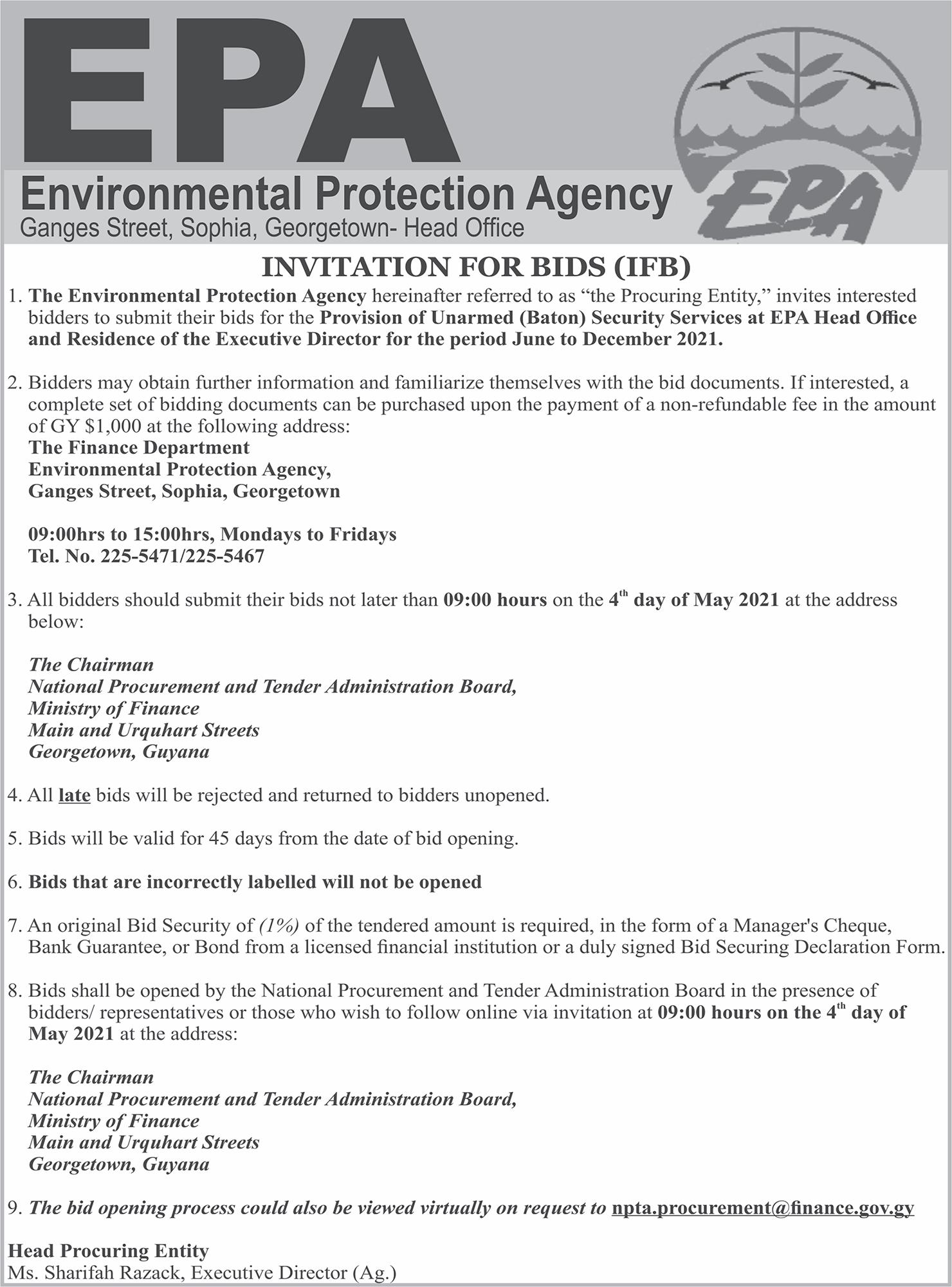

• Between the fingers • Around fingernails • Armpits • Waistline • Inner parts of the wrists • Inner elbow • Soles of the feet • Breasts, particularly the areas around the nipples • Male genitalia • Buttocks • Knees • Shoulder blades
Infants and young children experience infestation in other areas of the body, including the:
• Scalp • Face • Neck • palms of the hands • Soles of the feet
At times, children can present with a widespread infestation, covering a majority of the body. Infants who are infested with scabies tend to exhibit symptoms of irritability, and sleeping and eating difficulties.
DIAGNOSIS
Scabies can sometimes be mistaken for dermatitis or eczema, as these skin conditions also cause itching and bumps on the skin. Anyone who is unsure about the cause of a skin condition should consult their physician, as over-the-counter medications cannot eradicate scabies.
Health Care workers can diagnose scabies by examining the skin, or by looking at skin scrapings under a microscope.
TREATMENT
Scabies is highly contagious, so anyone living with a patient diagnosed with the condition, or who has had close contact with the patient, would most likely be recommended to receive treatment for scabies even if they do not have any symptoms. This includes any person with whom the patient has had recent intimate contact.
Scabies is generally treated with topical medications such as 5 percent permethrin cream, crotamiton cream, or lindane lotion. In some cases, a 25 percent benzyl benzoate lotion or 10 percent sulfur ointment may be used. Most topical preparations are applied at night and washed off in the morning. • Ivermectin, an oral medication, may be recommended for people who are immunocompromised, those with crusted scabies, or those who did not respond to topical therapy. • Other medications, such as antihistamines, anti-itching lotions, antibiotics, and steroid creams, might be prescribed to offer relief from symptoms.
Treatment with prescribed medications would generally kill mites quickly. The itching and rash may initially become worse.
However, skin healing should be seen by 4 weeks after treatment. Some people require more than one course of treatment to fully rid themselves of mites.
HOME REMEDIES
Home solutions for scabies are often not recommended. Some infestations can resolve without treatment. However, herbal treatments, such as tea tree and neem oils, have not consistently been shown to treat scabies. It is therefore advisable to visit a health facility and be reviewed by a physician.
PREVENTION
To prevent re-infestation and spread, take the following steps: • Wash or dry-clean all clothes, towels, linens, etc. When washing, use hot soapy water and dry on high heat. Place items that cannot be washed in a sealed plastic bag for one to several weeks to starve the mites. • Vacuum the entire home on the day treatment is initiated, including carpets, rugs, upholstery, etc., and discard the bag or thoroughly clean the vacuum’s canister.
Anyone can get scabies. It has nothing to do with poor hygiene.
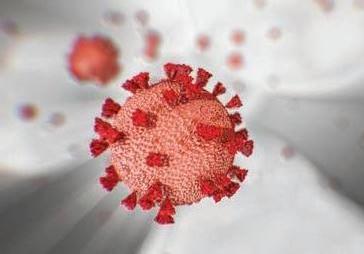
COVID-19 and Pregnancy (Part I)
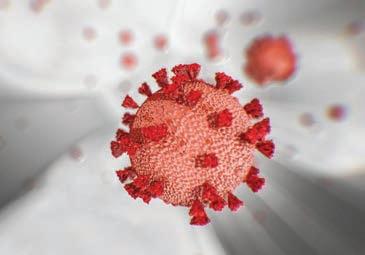
Contributed by: dr. narine Singh Chief MediCal offiCer MiniStry of health
Since the first report (December 2019) of the COVID-19, the number of confirmed cases and associated mortality and morbidity has increased rapidly. Pregnant women are considered a high risk group because of concerns about the effects of COVID -19 on them during and after pregnancy and on their neonate.
Due to changes in their bodies and immune systems, we know that pregnant women can be badly affected by some respiratory infections. The overall risk of COVID-19 to pregnant women is low. However, pregnancy increases the risk for severe illness with COVID-19.
Pregnant women who have COVID-19 appear more likely to develop respiratory complications requiring intensive care than women who aren’t pregnant. Pregnant women or recently pregnant women who are older, overweight, and have pre-existing medical conditions such as hypertension and diabetes seem to have an increased risk of developing severe COVID-19.
Latest Research
New research findings published in the September 2020 edition of the BMJ help to shed light on the risks of COVID-19 for pregnant women and their babies.
The paper suggests that pregnant women seen with suspected or confirmed COVID-19 are less likely to experience a fever or muscle pain, but if they develop severe disease they are more likely to need intensive care than non-pregnant women with COVID-19.
There is currently no data to suggest increased risk of miscarriage or early pregnancy loss in relation to COVID-19. It isn’t yet known how frequently COVID-19 causes problems during pregnancy or affects the health of the baby after birth.
Some research suggests that pregnant women with COVID-19 are more likely to have a premature birth and their babies are more likely to be admitted to a neonatal unit.
Mother to Child Transmission
It is still not known for sure if a pregnant woman with COVID-19 can pass the virus to her fetus or baby during pregnancy or delivery. Early studies indicated no evidence for vertical transmission of COVID-19 from mother to child in late pregnancy, but more recent reports indicate that vertical transmission may occur in some cases.
To date, the active virus has not been found in samples of fluid around the baby in the womb or breast milk. Community efforts to control the spread of the COVID-19 virus might affect your access to routine prenatal care.
It is strongly advised that antenatal and postnatal care should be regarded as essential, and that pregnant women will continue to need at least as much support, advice, care and guidance in relation to pregnancy, childbirth and early parenthood as before.
It is recommended that in-person appointments be deferred by seven days after the start of symptoms of COVID-19 or 14 days if another person in the household has symptoms.
Where in-person appointments are required, pregnant patients with symptoms or confirmed COVID-19 who require obstetric care are advised to notify the hospital or clinic before they arrive in order for infection control to be put in place.
Remote Appointments
To minimize the risk of infection, some appointments may be conducted remotely via teleconferencing or video conferencing, where possible. This is being done especially for those in the early stages of low risk pregnancy by the Maternal and Child Health (MCH) Department of the Ministry of Health in several regions.
Talk to your health care provider about whether the use of virtual prenatal care is an option for you, if it’s available in your area, and how it works. Ask your health care provider if there are any tools that might be helpful to have at home, such as a blood pressure monitor. To make the most of any virtual visits, prepare a list of questions ahead of time and take detailed notes during the visit.
If you have certain highrisk conditions during pregnancy, virtual visits might not be an option. Ask your health care provider about how your care might be affected. Contact your health care provider right away if you have COVID-19 symptoms or if you’ve been exposed to someone with COVID-19.
It’s recommended that you are tested for the virus that causes COVID-19, if testing supplies are available. Call your health care provider ahead of time to tell him or her about your symptoms and possible exposure before going to your appointment.
If you have COVID-19 and are pregnant, your treatment will be aimed at relieving symptoms and may include getting plenty of fluids and rest, as well as using medication to reduce fever, relieve pain or lessen coughing. If you’re very ill, you may need to be treated in the hospital
In Part II next week, we will look at labour and delivery, breastfeeding, postpartum guidance and safe medical treatment to conclude this topic. Do not miss the conclusion!
Article submitted as part of the Ministry of Health’s COVID-19 public information and education programme. For questions, email ministersecretaryhealth@gmail.com.



Over the last few weeks, the PET CARE column has been dealing with skin ailments afflicting companion animals. This topic is coming to a close, and the final episode was planned to discuss “CONTACT DERMATITIS”. Lo and behold, on April 5th, 2021, a comprehensive description of this condition was published in the Guyana Times. Dr. Tariq Jagnarine admirably compiled all the salient aspects associated with this skin problem.
However, I will still persist with discussion as it relates to our companion animals, is only because the problem is so pervasive that it demands extra attention.
First of all, the entire body of most dogs and cats exist in an environment not far off the ground, where all sorts of germs and toxic materials are present and accessible. Pets do not wear protective clothing and can easily come in contact (via soil, grass, sand, etc.) with toxic materials and biological pathogens. In addition, in Guyana all life exists in an environment close to the equator with very high humidity levels. On the coast, where many of our pets exist, their homes are below sea level. When all of these factors are taken into consideration, is it any wonder that our vulnerable animals (and even us humans) are fraught with skin lesions and diseases?
Though often similar in symptoms displayed, Contact Dermatitis and Allergic Contact Dermatitis, both mentioned by Dr. Jagnarine, are separate and different conditions in dogs and cats. Actually, dogs and cats having contact with irritating chemicals will consequentially develop the itch/ scratch syndrome with varying intensities. But if the pet is also allergic to the chemical substance, the symptoms may become very severe – to the point of self-mutilation. I should add that it has been my experience that, only after repeated exposure/ contact to/ with the chemical causing the allergic reaction, will there be a full-blown reaction (see symptoms below).
SYMPTOMS:
The symptoms are: • Itching/ scratching • Often red bumps on the skin emerge. If the caregiver cannot actually see the bumps, say on a black coat dog, then the bumps cab be felt, by just rubbing the palm of the hand on the coat of the dog/ cat. • Inflammation (redness) on the skin. • Wet eczemas can develop (“weepy” spots on the skin). These, if not treated can develop into serum-filled blisters, ulcerations and pus. • Loss of hair. • Dandruff-like crusts and flakes (especially in the areas where anti-flea collars are placed).
CAUSES
The common irritants (allergens) are: • Acids/ Alkalis (household bleaches/ detergents/ sanitizers). • Insecticides. • Solvents. • Soaps/ shampoos/ medications applied to the skin. • Petroleum by-products (e.g. rubbing the animal with old engine/ waste oil to supposedly get rid of mange.). • Flea powders and flea collars. • Too much exposure to the sun’s rays. • Stinging Nettle • Dog deodorants – really not necessary
Caregivers will find these skin lesions on the feet, chin, abdomen, groin and scrotum. These, of course, are those very areas which most likely will come in contact with toxic materials/ chemicals, since dogs especially lie on their hocks (lower hind legs) and stifles (upper hind legs).
I mentioned the word “materials” above, because it has been found that animals can be allergic to food bowls (especially the plastic and rubber variety). Food dish dermatitis usually affects on the nose.

TREATMENT AND PREVENTION
Well, the caregiver/ veterinary advisor must identify the chemical (allergen) causing the allergic reaction – and then remove same from contact with the pet, and/ or the pet from the area where you have placed the chemical. Bear in mind that the chemical might exist in the materials used to manufacture carpets and sofa covers, etc.
Your vet will advise on the usage and dosage of antibiotics/ cortisones/ ant-allergy medication which might be introduce to assuage the problem.
N.B. Over the decades, it is becoming clearer that inbred dogs and cats may have a decrease in their ability to fight off diseases (immune deficiencies), and are therefore more easily susceptible to ailments, including those associated with (allergic) Contact Dermatitis.





